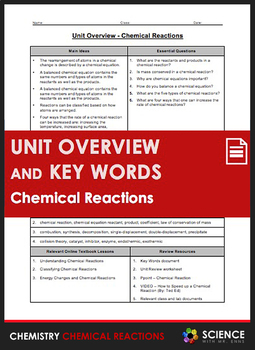Chemical Reactions Rates Collision Theory Chemistry Unit Overview & Vocabulary
- Zip
Also included in
- This bundle is a set of 6 Unit Overview and Key Words products that I use during a typical year in chemistry. The unit overview documents are designed to be used as handouts to introduce upper middle school or lower high school students to multiple chemistry units. They are also highly useful for ePrice $10.80Original Price $13.50Save $2.70
- This unit bundle product contains 24 resources needed for a typical upper middle school and lower high school chemistry unit on chemical reactions. Topics include: physical and chemical changes, chemical equations, balancing equations, law of conservation of mass, types of chemical reactions, ratesPrice $61.40Original Price $76.75Save $15.35
- This is a custom bundle created for Suzanne. It is a collection of various class forms and resources, nature of science and chemistry products. Bundle Contents:NGSS Middle School Chemistry Curriculum - Full Course BundleSuper Bundle – Scientific Method & MetricsBundle - Class Forms, Notices, andPrice $258.02Original Price $368.10Save $110.08
- This is a custom bundle created for Lana. It is a collection of chemistry and physics unit bundles.Bundle Contents:UNIT BUNDLE - Forces and Newton's LawsUNIT BUNDLE - EnergyUNIT BUNDLE - Classification of MatterUNIT BUNDLE - Atoms and the Periodic TableUNIT BUNDLE - Chemical ReactionsWant Your Own CPrice $213.92Original Price $305.60Save $91.68
- This is a custom bundle created for Craig. It is a collection of chemistry and physics unit bundles (minus the unit PPTs and lab activities) and a bundle on metric conversions.Bundle Contents:BUNDLE - Metric Conversions ResourcesUNIT BUNDLE - Classification of Matter (No Unit PPT, No Labs)UNIT BUNDLPrice $285.60Original Price $408.25Save $122.65
Description
This 3-page Unit Overview and Key Words product serves as a student handout that introduces an upper middle school or high school unit on chemical reactions. It includes enduring understandings, essential questions, science skills or outcomes, relevant unit sections, and key vocabulary terms, all in one condensed document. Finally, this document features a multi-page glossary of key vocabulary terms and their definitions, in alphabetical order.
How I Use This Product:
I typically hand out Page 1 of this unit overview document to my students on the first day of a new topic. I usually photocopy it on a brightly-colored piece of paper so that the page provides a nice delineation point in their binders or folders that visually separates the different science units I teach from one another. In addition, I upload the vocabulary pages to Google Drive folder for that unit so that my students can have access to it throughout the course of study.
Product Contents:
Section 1: Unit Overview: (1 page)
- Unit Name
- Enduring Understandings
- Essential Questions
- Science Skills
- Key Vocabulary Terms (in order of appearance)
- Relevant Sections (this can easily be modified to suit your needs)
- Review Resources (this can easily be modified to suit your needs)
Section 2: Key Vocabulary Words: (2 page)
- Key vocabulary terms and their definitions, in alphabetical order
- Each page is designed to be folded in half and cut to make review flash cards!
Downloadable in 2 Formats:
- This worksheet comes in 2 formats: a static PDF document and fully-editable PPT document
- Download the detailed preview to see EXACTLY what you are purchasing!
You Might Also Like the Following Unit Resources:
UNIT BUNDLE - Chemical Reactions
PPT - Jeopardy Game: Chemical Reactions Review
Unit Overview & Key Words - Chemical Reactions Unit
Activity - Physical & Chemical Properties & Changes Sorting Cards (2 Set Bundle)
Worksheet - Physical and Chemical Properties and Changes
Worksheet - What are Chemical Equations?
Worksheet - Balancing Chemical Equations (2 Worksheet Bundle)
Worksheet - What are the Types of Chemical Reactions?
Worksheet - Naming Compounds, Balancing Equations & Classifying Reactions
Worksheet - What is Collision Theory?
Lab - Mystery Powders - Physical and Chemical Properties of Matter
Lab - Ziploc Bag Physical and Chemical Changes
Lab - Signs of a Chemical Reaction
Lab - Great Steel Wools of Fire (A Conservation of Mass Investigation)
Lab - Double Displacement Reactions
Lab - Alka-Seltzer Rate of Reaction - Classroom Lab
Lab - Alka-Seltzer Rate of Reaction - Virtual Lab
Lab - Disappearing X Sodium Thiosulfate Rate of Reaction - Classroom Lab
Lab - Disappearing X Sodium Thiosulfate Rate of Reaction - Virtual Lab
Quiz - Balancing Chemical Equations (4 Quiz Bundle)
Quiz - Types of Chemical Reactions
Unit Review - Chemical Reactions
Unit Test - Chemical Reactions
You Might Also Like the Following Unit Overview & Key Words Products:
BUNDLE - Unit Overviews and Key Words for Anatomy Units (Advanced)
BUNDLE - Unit Overviews and Key Words for Biology Units
BUNDLE - Unit Overviews and Key Words for Chemistry Units
BUNDLE - Unit Overviews and Key Words for Earth Science Units
BUNDLE - Unit Overviews and Key Words for Physics Units
Anatomy Unit Overview & Key Words Products:
Unit Overview & Key Words - Circulatory System (Advanced)
Unit Overview & Key Words - Digestive System (Advanced)
Unit Overview & Key Words - Endocrine System (Advanced)
Unit Overview & Key Words - Immune System (Advanced)
Unit Overview & Key Words - Integumentary System (Advanced)
Unit Overview & Key Words - Muscular System (Advanced)
Unit Overview & Key Words - Nervous System (Advanced)
Unit Overview & Key Words - Reproductive System (Advanced)
Unit Overview & Key Words - Respiratory System (Advanced)
Unit Overview & Key Words - Sensory System (Advanced)
Unit Overview & Key Words - Skeletal System (Advanced)
Unit Overview & Key Words - Urinary System (Advanced)
Biology Unit Overview & Key Words Products:
Unit Overview & Key Words - Biochemistry
Unit Overview & Key Words - Cells
Unit Overview & Key Words - Classification
Unit Overview & Key Words - Ecology
Unit Overview & Key Words - Evolution and Natural Selection
Unit Overview & Key Words - Genetics and Heredity
Unit Overview & Key Words - Plants
Unit Overview & Key Words - Population Ecology
Chemistry Unit Overview & Key Words Products:
Unit Overview & Key Words - Acids, Bases, and Salts Unit
Unit Overview & Key Words - Chemical Bonds Unit
Unit Overview & Key Words - Chemical Reactions Unit
Unit Overview & Key Words - Classification of Matter Unit
Unit Overview & Key Words - Properties of Atoms and the Periodic Table Unit
Unit Overview & Key Words - Solids, Liquids, and Gases Unit
Earth Science Unit Overview & Key Words Products:
Unit Overview & Key Words - Astronomy I: Sun, Earth, Moon System Unit
Unit Overview & Key Words - Astronomy II: Stars, Galaxies, and the Universe Unit
Unit Overview & Key Words - Climate Unit
Unit Overview & Key Words - Earth's History Unit
Unit Overview & Key Words - Earth's Surface Unit
Unit Overview & Key Words - Earthquakes and Volcanoes Unit
Unit Overview & Key Words - Plate Tectonics Unit
Unit Overview & Key Words - Rocks and Minerals Unit
Unit Overview & Key Words - Weather Unit
Physics Unit Overview & Key Words Products:
Unit Overview & Key Words - Motion Unit
Unit Overview & Key Words - Forces Unit
Unit Overview & Key Words - Energy Unit
Unit Overview & Key Words - Energy Sources Unit
Unit Overview & Key Words - Work and Machines Unit
Unit Overview & Key Words - Mechanical Waves and Sound
Unit Overview & Key Words - Electromagnetic Waves, Light and Optics
Unit Overview & Key Words - Electricity Unit
Unit Overview & Key Words - Magnetism Unit
Connect with More Science With Mr. Enns Resources:
Be sure to follow my TpT store by clicking on the Follow Me next to my seller picture to receive notifications of new products and upcoming sales.
Terms of Use:
Copyright © Douglas Enns. All rights reserved by author. This product is to be used by the original downloader only. Copying for more than one teacher, classroom, department, school, or school system is prohibited. This product may not be distributed or displayed digitally for public view. Failure to comply is a copyright infringement and a violation of the Digital Millennium Copyright Act (DMCA). Clipart and elements found in this document are copyrighted and cannot be extracted and used outside of this file without permission or license. Intended for classroom and personal use ONLY.










